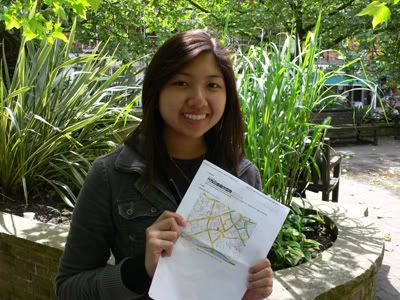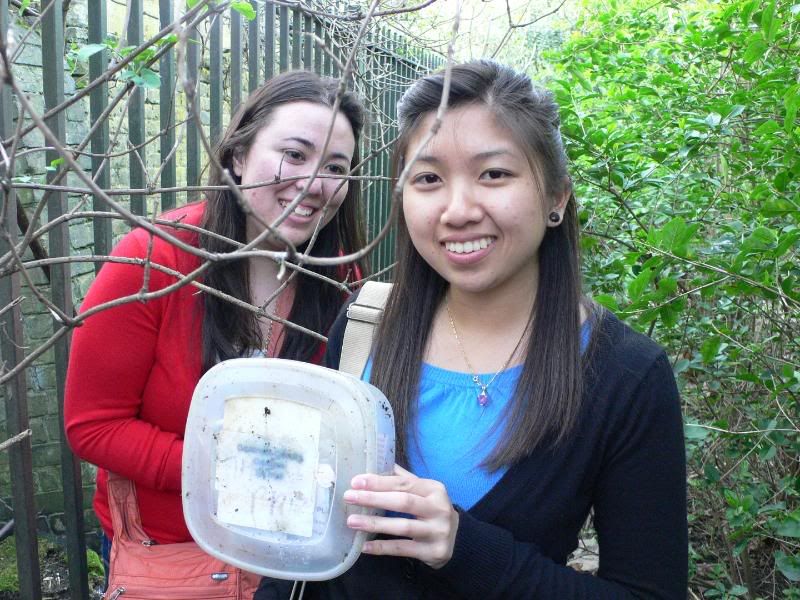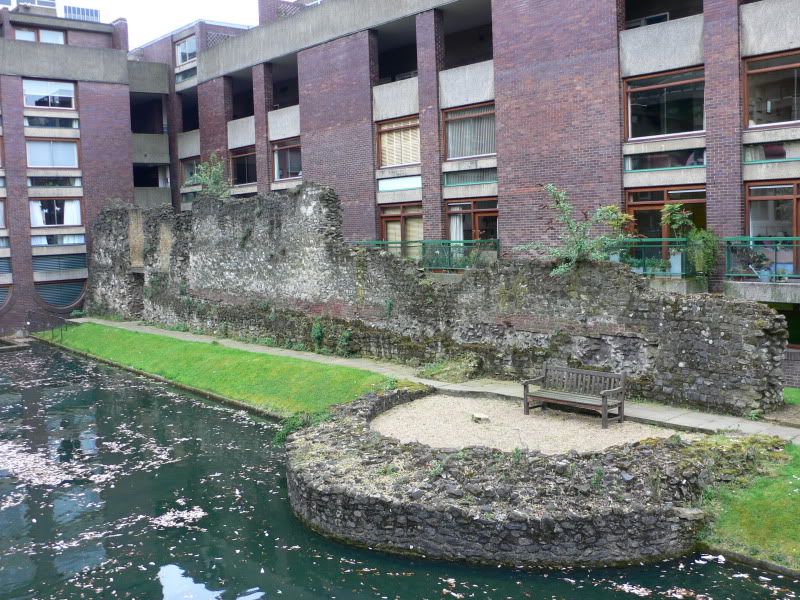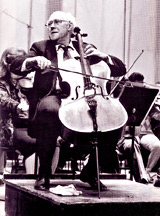Sunday 31 May 2009
Philosophy of Art
Art is an essential form of expression. The way in which people create art and view art differs greatly. Throughout this course, I have had a better understanding of my aesthetic. I would generally look at a piece of art and think it was beautiful and that was why I liked it. Now I can say I like this piece of art because....I am able to make a case for why one art piece is better than another, in my own opinion as well as with a set of specific criteria. I have thoroughly enjoyed trying to get into the artists' head to try and figure out what they were thinking when creating their piece, I did this mostly at the Tate Modern. I liked the Saatchi gallery, with its display of Middle Eastern art with a feminist perspective. I also enjoyed the displays at the Tate Modern and Tate Britain, the Dominique Gonzalez-Foerster exhibition and the JMW Turner exhibition, respectively. I found that analyzing one's own aesthetic is a bit difficult, but as the course progressed, I had a better understanding of art. Being able to appreciate and understand various art forms is a wonderful thing.
Geocaching Fun!


Geocaching is a wonderful way of exploring various cities. Geocaching in London allowed me to visit places that I probably would not have visited on my own. I have really enjoyed geocaching, despite how frustrating some of
 the multi-cache finals were, I had a lot of fun. Finding physical caches were a bit difficult and require a lot of stealth. An example of a great geocaching adventure, was the Greenwich geocache. It took us to the Royal Observatory where I learned that Prime Meridian is not where the Prime Meridian is labeled. This geocache took us to the real location, just few hundred feet away. It was nice to geocache because it takes you everywhere, and many of the geocaches that we did as a class teaches you a lot about the history of London. An example of a geocache that had some history to it was the geocache about the Roman Wall which led us to several parts of the Roman wall that still exist. Geocaching is not j
the multi-cache finals were, I had a lot of fun. Finding physical caches were a bit difficult and require a lot of stealth. An example of a great geocaching adventure, was the Greenwich geocache. It took us to the Royal Observatory where I learned that Prime Meridian is not where the Prime Meridian is labeled. This geocache took us to the real location, just few hundred feet away. It was nice to geocache because it takes you everywhere, and many of the geocaches that we did as a class teaches you a lot about the history of London. An example of a geocache that had some history to it was the geocache about the Roman Wall which led us to several parts of the Roman wall that still exist. Geocaching is not j ust about finding, you can also place geocaches, which I find is a lot more complicated. Our class geocache was a lot of fun, but gathering all the information needed to create the cache is very time consuming and requires some innovative thinking. I am glad to have learned of geocaching, it is great thing to do while traveling, and I hope to continue geocaching as I travel the world in my future travels.
ust about finding, you can also place geocaches, which I find is a lot more complicated. Our class geocache was a lot of fun, but gathering all the information needed to create the cache is very time consuming and requires some innovative thinking. I am glad to have learned of geocaching, it is great thing to do while traveling, and I hope to continue geocaching as I travel the world in my future travels.Thursday 21 May 2009
Master-Pupil Evaluation

Master-Pupil Evaluation
When looking at these two sketches, I believe that the drawing on the left belongs to DaVinci and the one on the right belongs to the pupil. The sketch on the left is superior to the one on the right, according to Rosenberg's Criteria of Excellence in Art, because in regards to form, the subject is much more realistic and has more depth. The lines are more distinct and the eyes are much more detailed and expressive in the drawing on the left. Both are great sketches, but the DaVinci sketch is obviously the superior of the two because it clearly shows a more accurate, rich, and expressive portrait of a woman.
Monday 18 May 2009
Rostropovich and Yo Yo Ma
 Ludwig van Beethoven composed Cello Sonatas No. 4 and No. 5 simultaneously in 1815, during a time in which he experienced a period of ailments and difficulties which included his deafness. Sonatas no. 4 and no. 5 were composed seven years after his sonata no. 3 for cello and piano and clearly belong to Beethoven’s last creative period (Wiki). Since then, there have been many variations and interpretations of Cello Sonata No. 4. Two variations include one by Rostropovich, the other by Yo Yo Ma.
Ludwig van Beethoven composed Cello Sonatas No. 4 and No. 5 simultaneously in 1815, during a time in which he experienced a period of ailments and difficulties which included his deafness. Sonatas no. 4 and no. 5 were composed seven years after his sonata no. 3 for cello and piano and clearly belong to Beethoven’s last creative period (Wiki). Since then, there have been many variations and interpretations of Cello Sonata No. 4. Two variations include one by Rostropovich, the other by Yo Yo Ma.
Both Rostropovich and Yo Yo Ma perform Beethoven's Cello Sonata No. 4, and with both you get two different interpretations of the same song. When listening to the Rostropovich interpretation, I can imagine it being played alongside a silent black and white film. It is as if the cello and the piano are hav
 ing a conversation, bantering back and forth. In that sense, the Rostropovich interpretation would help narrate the silent film. The Yo Yo Ma interpretation is much different. It is softer and more harmonious than the Rostropovich interpretation. Yo Yo Ma performs a much gentler version of the Sonata and at a slightly faster tempo than Rostropovich.
ing a conversation, bantering back and forth. In that sense, the Rostropovich interpretation would help narrate the silent film. The Yo Yo Ma interpretation is much different. It is softer and more harmonious than the Rostropovich interpretation. Yo Yo Ma performs a much gentler version of the Sonata and at a slightly faster tempo than Rostropovich.
Sunday 17 May 2009
Romeo & Juliet at the Globe
 Romeo and Juliet is most commonly known as one of William Shakespeare's great tragedies, who knew it could be a comedy as well. I have seen several different versions of Shakespeare's Romeo and Juliet, and the production at the Globe Theatre was once again a new take on the classic. Most often when seeing Romeo and Juliet productions, it is very dramatic and much more serious. The production at the Globe was much different, it was much happier. All the scenes had a lighter tone, even the death scenes did not feel as depressing. Shakespeare's structure of Romeo and Juliet included switching between comedy and tragedy, most productions have a very tragic focus, whereas the production at the Globe emphasized much of the comedy. It wasn't what I was expecting when I went to see Romeo and Juliet. I went to the Globe Theatre thinking I would be standing and watching a very serious
Romeo and Juliet is most commonly known as one of William Shakespeare's great tragedies, who knew it could be a comedy as well. I have seen several different versions of Shakespeare's Romeo and Juliet, and the production at the Globe Theatre was once again a new take on the classic. Most often when seeing Romeo and Juliet productions, it is very dramatic and much more serious. The production at the Globe was much different, it was much happier. All the scenes had a lighter tone, even the death scenes did not feel as depressing. Shakespeare's structure of Romeo and Juliet included switching between comedy and tragedy, most productions have a very tragic focus, whereas the production at the Globe emphasized much of the comedy. It wasn't what I was expecting when I went to see Romeo and Juliet. I went to the Globe Theatre thinking I would be standing and watching a very serious  rendition of the play. Surprisingly, I liked this happier version of Romeo and Juliet. I really enjoyed the performers emphasis in the comic relief, those who played Mercutio and Benvolio were great. In the end, however, I found Juliet to be a bit annoying, and Romeo was very expressive. Overall, I found that the play was really well done.
rendition of the play. Surprisingly, I liked this happier version of Romeo and Juliet. I really enjoyed the performers emphasis in the comic relief, those who played Mercutio and Benvolio were great. In the end, however, I found Juliet to be a bit annoying, and Romeo was very expressive. Overall, I found that the play was really well done.
Friday 15 May 2009
The British Museum

The British Museum's Great Court
The Great Court at the British Museum is something to marvel at once you step into the British Museum. In December of 2000, Her Majesty the Queen conducted the formal opening of the Queen Elizabeth II Great Court. It is two square acres, enclosed by a magnificent glass ceiling. The Great Court increased public space in the Museum by forty per cent, allowing visitors to move freely around the Main floor for the first time in 150 years and visitors can now choose from a number of different approaches to the galleries. The first thing that I noticed as I walked into the Great Court was the spiraling staircase that leads your gaze up toward the incredible ceiling. The Great Court's glass and steel ceiling is more than just a ceiling, I find that it's like another piece on display in the museum. It's design is reminiscent of a jigsaw puzzle. The Great Court is a wonderful part of the British Museum, I especially enjoy the Roman style features within the the museum.
The Battle of Lapiths and Centaurs

In my various visits to the British Museum, I always make my way to the Parthenon Room. Ancient Greece has always been quite intriguing. The metopes that depict the "battle of Lapiths and Centuars," were interesting. The Centaurs have faces with animal features, and are armed with tree branches while the Lapiths fight nude, some armed with a sword. Each piece depict a different part of the battle. Despite their damage, the sequence of sculptures is a great piece of art.
Wednesday 13 May 2009
Bloomsbury Group
 The Bloomsbury Group was an interesting group. It is difficult to determine who was actually in the group, every source that I looked at had varying members. The Bloomsbury Group was a group of friends and relatives who lived in or near London. According to Wikipedia, Their work deeply influenced literature, aesthetics, criticism, and economics as well as modern attitudes towards feminism, pacifism, and sexuality. Its best known members were Virginia Woolf, John Maynard Keynes, E. M. Forster, and Lytton Strachey (Wikipedia). I have listed the members of the group as listed at Tate.org.uk and Wikipedia.org, their respective addresses were found at english-heritage.org.uk.
The Bloomsbury Group was an interesting group. It is difficult to determine who was actually in the group, every source that I looked at had varying members. The Bloomsbury Group was a group of friends and relatives who lived in or near London. According to Wikipedia, Their work deeply influenced literature, aesthetics, criticism, and economics as well as modern attitudes towards feminism, pacifism, and sexuality. Its best known members were Virginia Woolf, John Maynard Keynes, E. M. Forster, and Lytton Strachey (Wikipedia). I have listed the members of the group as listed at Tate.org.uk and Wikipedia.org, their respective addresses were found at english-heritage.org.uk.Helen Anrep (Art supporter)
Became involved with the Bloomsbury circle in 1924-5 when she met Roger Fry at a party at Vanessa Bell's studio.
Clive Bell (Art Critic)
Resided in 50 Gordon Square with his wife Vanessa
Vanessa Bell (Artist)
Lived at 46 Gordon Square with her 3 siblings, later she resided in 50 Gordon Square with husband Clive
Quentin Bell
Son of Clive and Vanessa Bell. Spent much of his childhood at Charleston and went on to become a writer, artist, and art historian.
E.M. Forester (Novelist and Essayist)
Lived in Arlington Park Mansions
Roger Fry (Artist and Critic)
1913-1919: Roger Fry’s Omega Studios at 33 Fitzroy Square
Duncan Grant (Artist)
1907-1911: his studio at 22 Fitzroy Square during this time
1907-1911: resided at 26 Fitzroy Square with John Maynard Keynes
John Maynard Keynes (Economist)
1916-1946: lived in 46 Gordon Square
Lady Ottoline Morrell (Literary Hostess and Patron of the Arts)
Lived here: 10 Gower Street, Westminster
Lytton Strachey (Biographer and Essayist)
1909-1924: resided in 51 Gordon Square
Leonard Woolf (Critic)
Virginia Woolf (Novelist and Essayist)
1907-1911: lived in 29 Fitzroy Square
Subscribe to:
Posts (Atom)
